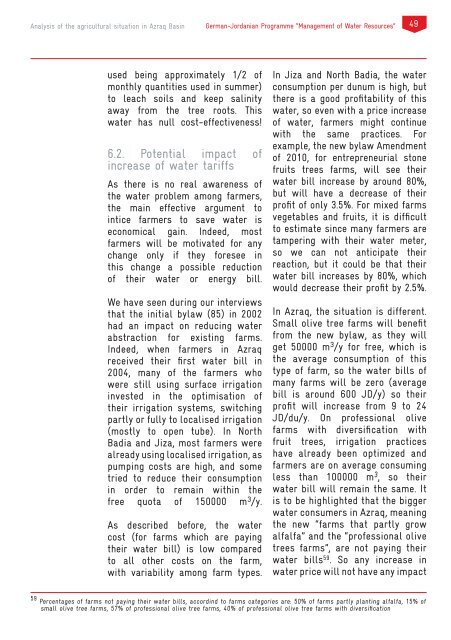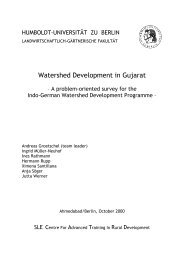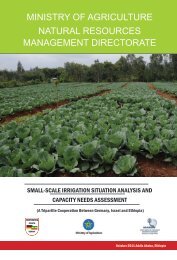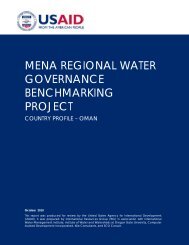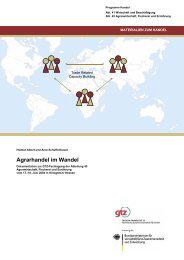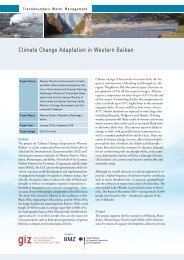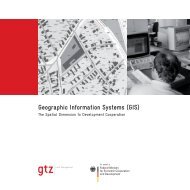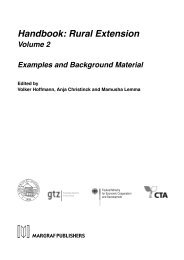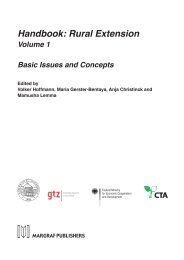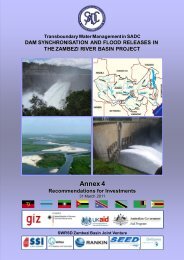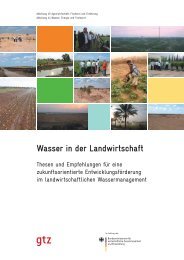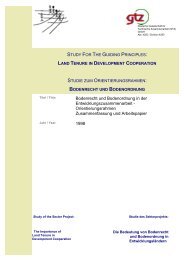Farming in the - WordPress.com
Farming in the - WordPress.com
Farming in the - WordPress.com
Create successful ePaper yourself
Turn your PDF publications into a flip-book with our unique Google optimized e-Paper software.
Analysis of <strong>the</strong> agricultural situation <strong>in</strong> Azraq Bas<strong>in</strong><br />
German-Jordanian Programme “Management of Water Resources”<br />
49<br />
used be<strong>in</strong>g approximately 1/2 of<br />
monthly quantities used <strong>in</strong> summer)<br />
to leach soils and keep sal<strong>in</strong>ity<br />
away from <strong>the</strong> tree roots. This<br />
water has null cost-effectiveness!<br />
6.2. Potential impact of<br />
<strong>in</strong>crease of water tariffs<br />
As <strong>the</strong>re is no real awareness of<br />
<strong>the</strong> water problem among farmers,<br />
<strong>the</strong> ma<strong>in</strong> effective argument to<br />
<strong>in</strong>tice farmers to save water is<br />
economical ga<strong>in</strong>. Indeed, most<br />
farmers will be motivated for any<br />
change only if <strong>the</strong>y foresee <strong>in</strong><br />
this change a possible reduction<br />
of <strong>the</strong>ir water or energy bill.<br />
We have seen dur<strong>in</strong>g our <strong>in</strong>terviews<br />
that <strong>the</strong> <strong>in</strong>itial bylaw (85) <strong>in</strong> 2002<br />
had an impact on reduc<strong>in</strong>g water<br />
abstraction for exist<strong>in</strong>g farms.<br />
Indeed, when farmers <strong>in</strong> Azraq<br />
received <strong>the</strong>ir first water bill <strong>in</strong><br />
2004, many of <strong>the</strong> farmers who<br />
were still us<strong>in</strong>g surface irrigation<br />
<strong>in</strong>vested <strong>in</strong> <strong>the</strong> optimisation of<br />
<strong>the</strong>ir irrigation systems, switch<strong>in</strong>g<br />
partly or fully to localised irrigation<br />
(mostly to open tube). In North<br />
Badia and Jiza, most farmers were<br />
already us<strong>in</strong>g localised irrigation, as<br />
pump<strong>in</strong>g costs are high, and some<br />
tried to reduce <strong>the</strong>ir consumption<br />
<strong>in</strong> order to rema<strong>in</strong> with<strong>in</strong> <strong>the</strong><br />
free quota of 150000 m 3 /y.<br />
As described before, <strong>the</strong> water<br />
cost (for farms which are pay<strong>in</strong>g<br />
<strong>the</strong>ir water bill) is low <strong>com</strong>pared<br />
to all o<strong>the</strong>r costs on <strong>the</strong> farm,<br />
with variability among farm types.<br />
In Jiza and North Badia, <strong>the</strong> water<br />
consumption per dunum is high, but<br />
<strong>the</strong>re is a good profitability of this<br />
water, so even with a price <strong>in</strong>crease<br />
of water, farmers might cont<strong>in</strong>ue<br />
with <strong>the</strong> same practices. For<br />
example, <strong>the</strong> new bylaw Amendment<br />
of 2010, for entrepreneurial stone<br />
fruits trees farms, will see <strong>the</strong>ir<br />
water bill <strong>in</strong>crease by around 80%,<br />
but will have a decrease of <strong>the</strong>ir<br />
profit of only 3.5%. For mixed farms<br />
vegetables and fruits, it is difficult<br />
to estimate s<strong>in</strong>ce many farmers are<br />
tamper<strong>in</strong>g with <strong>the</strong>ir water meter,<br />
so we can not anticipate <strong>the</strong>ir<br />
reaction, but it could be that <strong>the</strong>ir<br />
water bill <strong>in</strong>creases by 80%, which<br />
would decrease <strong>the</strong>ir profit by 2.5%.<br />
In Azraq, <strong>the</strong> situation is different.<br />
Small olive tree farms will benefit<br />
from <strong>the</strong> new bylaw, as <strong>the</strong>y will<br />
get 50000 m 3 /y for free, which is<br />
<strong>the</strong> average consumption of this<br />
type of farm, so <strong>the</strong> water bills of<br />
many farms will be zero (average<br />
bill is around 600 JD/y) so <strong>the</strong>ir<br />
profit will <strong>in</strong>crease from 9 to 24<br />
JD/du/y. On professional olive<br />
farms with diversification with<br />
fruit trees, irrigation practices<br />
have already been optimized and<br />
farmers are on average consum<strong>in</strong>g<br />
less than 100000 m 3 , so <strong>the</strong>ir<br />
water bill will rema<strong>in</strong> <strong>the</strong> same. It<br />
is to be highlighted that <strong>the</strong> bigger<br />
water consumers <strong>in</strong> Azraq, mean<strong>in</strong>g<br />
<strong>the</strong> new “farms that partly grow<br />
alfalfa” and <strong>the</strong> “professional olive<br />
trees farms”, are not pay<strong>in</strong>g <strong>the</strong>ir<br />
water bills 59 . So any <strong>in</strong>crease <strong>in</strong><br />
water price will not have any impact<br />
59 Percentages of farms not pay<strong>in</strong>g <strong>the</strong>ir water bills, accord<strong>in</strong>d to farms categories are: 50% of farms partly plant<strong>in</strong>g alfalfa, 15% of<br />
small olive tree farms, 57% of professional olive tree farms, 40% of professional olive tree farms with diversification


